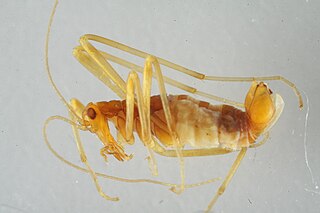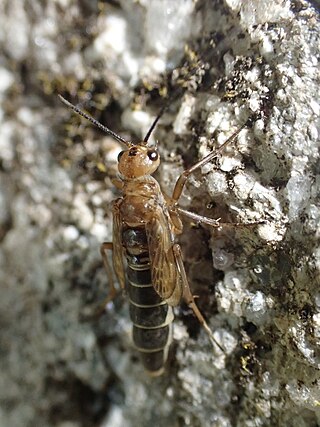
Mecoptera is an order of insects in the superorder Endopterygota with about six hundred species in nine families worldwide. Mecopterans are sometimes called scorpionflies after their largest family, Panorpidae, in which the males have enlarged genitals raised over the body that look similar to the stingers of scorpions, and long beaklike rostra. The Bittacidae, or hangingflies, are another prominent family and are known for their elaborate mating rituals, in which females choose mates based on the quality of gift prey offered to them by the males. A smaller group is the snow scorpionflies, family Boreidae, adults of which are sometimes seen walking on snowfields. In contrast, the majority of species in the order inhabit moist environments in tropical locations.

Apteropanorpidae is a family of wingless scorpionflies containing a single genus, Apteropanorpa, with four named species. These species, also called Tasmanian snow scorpionflies, are found in moss in Tasmania and southern Australia. The adults are generalised predators. The larvae live in moss and are locally common.

Bittacidae is a family of scorpionflies commonly called hangingflies or hanging scorpionflies.

Boreidae, commonly called snow scorpionflies, or in the British Isles, snow fleas are a very small family of scorpionflies, containing only around 30 species, all of which are boreal or high-altitude species in the Northern Hemisphere.

Boreus brumalis, the mid-winter boreu, is a species of snow scorpionfly in the family Boreidae. It is found in North America.
Boreus nix is a species of snow scorpionfly in the family Boreidae. It is found in North America.

Zeugomantispa is a genus of mantidflies in the family Mantispidae. There are at least three described species in Zeugomantispa.
Lecontella brunnea is a species of checkered beetle in the family Cleridae. It is found in Central America and North America.
Lecontella is a genus of checkered beetles in the family Cleridae. There are at least four described species in Lecontella.
Caurinus dectes is a species of snow scorpionfly in the family Boreidae. It is found in North America.

Brachypanorpa is a genus of scorpionflies in the family Panorpodidae. There are about five described species in Brachypanorpa.
Boreus elegans is a species of snow scorpionfly in the family Boreidae. It is found in North America.
Dearthrus is a genus of carpet beetles in the family Dermestidae. There are at least two described species in Dearthrus.
Apterobittacus is a genus of hangingflies in the family Bittacidae. There is one described species in Apterobittacus, A. apterus.
Boreus nivoriundus, known generally as the snow-born boreus or snow scorpionfly, is a species of snow scorpionfly in the family Boreidae. It is found in North America.
Beameria is a genus of cicadas in the family Cicadidae. There are at least three described species in Beameria.
Panorpa debilis is a species of common scorpionfly in the family Panorpidae. It is found in North America.
Boreus insulanus is a species of snow scorpionfly in the family Boreidae. It is endemic to Vancouver Island.
Lecontella gnara is a species of checkered beetle in the family Cleridae. It is found in Central America and North America.
Boreus coloradensis is a species of snow scorpionfly in the family Boreidae. It is found in North America.







